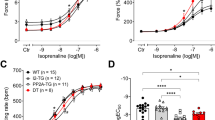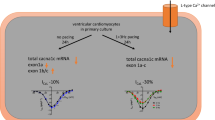Abstract
We investigated the expression of α1 and β subunits of the L-type Ca2+ channel on the protein level in cardiac preparations from normal human heart ventricles and from the hypertrophied septum of patients with hypertrophic obstructive cardiomyopathy (HOCM). 1,4-Dihydropyridine (DHP) binding and immunorecognition by polyclonal antibodies directed against the C-terminal amino acid sequences of the β2 and β3 subunits were used for detection and quantification of α1, β2, and β3 subunits. Bmax of high-affinity DHP binding was 35±2 fmol/mg protein in HOCM and 20±2 fmol/mg protein in normal human hearts (P<0.05). In rabbit hearts the anti-β2 subunit antibody immunoprecipitated 80% of the total amount of DHP-labeled Ca2+ channels present in the assay. Under identical experimental conditions 25% of labeled Ca2+ channels were recovered in the immunoprecipitates of both normal and HOCM ventricles. A similar partial immunoprecipitation was observed in pig hearts. Immunoblot analysis demonstrated that the β2 subunit was associated with the DHP receptor/Ca2+ channel in cardiac muscle of rabbit, pig, and human heart. In neither of these purified cardiac Ca2+ channels was the β3 subunit isoform detected. Our results suggest that both α1 and β2 subunit expression is upregulated in HOCM in a coordinate manner.
Similar content being viewed by others
Abbreviations
- B max :
-
Maximal number of binding sites
- DHP :
-
1,4-Dihydropyridine
- HOCM :
-
Hypertrophic obstructive cardiomyopathy
- NH :
-
Normal human heart
References
Hullin R, Biel M, Flockerzi V, Hofmann F (1993) Tissue-specific expression of calcium channels. Trends Cardiovasc Med 3:48–54
Catterall WA, Striessnig J (1992) Receptor sites for Ca2+channel antagonists. Trends Pharamacol Sci 13:256–262
Wagner JA, Reynolds IJ, Weisman HF, Dudek P, Weisfeldt ML, Snyder SH (1986) Ca2+-antagonist receptors in cardiomyopathic hamster: selective increases in heart, muscle, brain. Science 232:515–517
Finkel MS, Patterson RE, Roberts WC, Smith TD, Keiser HR (1988) Calcium channel binding characteristics in the human heart. Am J Cardiol 62:1281–1284
Wagner JA, Sax FL, Weisman HF, Porterfield JK, McIntosh C, Weisfeldt ML, Snyder SH, Epstein SE (1989) Ca2+-antagonist receptors in the atrial tissue of patients with hypertrophic cardiomyopathy. N Engl J Med 320:755–761
Takahashi T, Allen PD, Lacro RV, Marks AR, Dennis AR, Schoen FJ, Grossman W, Marsh JD, Izumo S (1992) Expression of dihydropyridine receptor (Ca2+ channel) and calsequestrin genes in the myocardium of patients with end-stage heart failure. J Clin Invest 90:927–935
Rasmussen RP, Minobe W, Bristow MR (1990) Calcium antagonist binding sites in failing and nonfailing human ventricular myocardium. Biochem Pharmacol 39:691–696
Mewes T, Ravens U (1994) L-type calcium currents of human myocytes from ventricle of non-failing and failing human hearts and from atrium. J Mol Cell Cardiol 26:1307–1320
Sen L, Xu DC, Marks AR (1994) Developmental changes of Ca transport gene expression in genetically determined cardiomyopathic hamster hearts. Circulation 90, part IV, no 0186
Neely A, Wei X, Olcese R, Birnbaumer L, Stefani E (1993) Potentiation by the β subunit of the ratio of the ionic current to the charge movement in the cardiac calcium channel. Science 262:575–578
Castellano A, Perez-Reyes E (1994) Molecular diversity of Ca2+ channel β subunits. Biochem Soc Trans 22:483–488
Perez-Reyes E, Castellano A, Kim HS, Bertrand P, Baggstrom E, Lacerda AE, Wei X, Birnbaumer L (1992) Cloning and expression of a cardiac/brain β subunit of the L-type calcium channel. J Biol Chem 267:1792–1797
Hullin R, Singer-Lahat D, Freichel M, Biel M, Dascal N, Hofmann F, Flockerzi V (1992) Calcium channel β subunit heterogeneity: functional expression of cloned cDNA from heart, aorta and brain. EMBO J 11:885–890
Collin T, Wang JJ, Nargeot J, Schwartz A (1993) Molecular cloning of three isoforms of the L-type voltage-dependent calcium channel β subunit from normal human heart. Circulation Res 72:1337–1344
Biel M, Hullin R, Freundner S, Singer D, Dascal N, Flockerzi V, Hofmann F (1991) Tissue-specific expression of high-voltage-activated dihydropyridine-sensitive L-type calcium channels. Eur J Biochem 200:81–88
Pragnell M, DeWaard M, Mori Y, Tanabe T, Snutch TP, Campbell KP (1994) Calcium channel β subunit binds to a conserved motif in the I–II cytoplasmic linker of the α1, subunit. Nature 368:67–70
DeWard M, Pragnell M, Campbell KP (1994) Ca2+ channel regulation by a conserved β subunit domain. Neuron 13:495–503
Witcher DR, De Waard M, Liu H, Pragnell M, Campbell KP (1995)Association of native Ca2+channel subunits with the α1 subunit interaction domain. J Biol Chem 270:18088–18093
Sakamoto J, Campbell KP (1991) A monoclonal antibody to the β subunit of the skeletal muscle dihydropyridine receptor immunoprecipitates the brain ω-conotoxin GVIA receptor. J Biol Chem 266:18914–18919
Haase H, Karczewski P, Beckert R, Krause EG (1993) Phosphorylation of the L-type calcium channel β subunit is involved in β-adrenergic signal transduction in canine myocardium. FEBS Lett 335:217–222
Haase H, Wallukat G, Flockerzi V, Nastainczyk W, Hofmann F (1994) Detection of skeletal muscle calcium channel subunits in cultured neonatal rat cardiac myocytes. Receptors Channels 2:41–52
Castellano A, Wei X, Birnbaumer L, Perez-Reyes E (1993) Cloning and expression of a third Ca2+ channel β subunit. J Biol Chem 268:3450–3455
Calovini T, Haase H, Morano I (1995) Steroid-hormone regulation of myosin subunit expression in smooth and cardiac muscle. J Cell Biochem 59:69–81
Lowry OH, Rosebrough NJ, Farr AL, Randall RJ (1951) Protein measurement with the folin phenol reagent. J Biol Chem 193:265–275
Haase H, Striessnig J, Holtzhauer M, Vetter R, Glossmann H (1991) A rapid procedure for the purification of cardiac 1,4-dihydropyridine receptors from porcine heart. Eur J Pharmacol 207:51–59
Karczewski P, Bartel S, Krause EG (1990) Differential sensitivity to isoprenaline of troponin I and phospholamban phosphorylation in isolated rat hearts. Biochem J 266:115–122
Striessnig J, Glossmann H (1991) Purification of L-type calcium channels drug receptors. Meth Neurosci 4:210–248
Schneider T, Regulla S, Nastainczyk W, Hofmann F (1992) Purification and structure of L-type calcium channels. In: Longstaff A, Revest P (eds) Methods in molecular biology protocols in molecular neurobiology, vol 13. Humana, Totowa, pp 273–286
Author information
Authors and Affiliations
Rights and permissions
About this article
Cite this article
Hasse, H., Kresse, A., Hohaus, A. et al. Expression of calcium channel subunits in the normal and diseased human myocardium. J Mol Med 74, 99–104 (1996). https://doi.org/10.1007/BF00196785
Received:
Accepted:
Issue Date:
DOI: https://doi.org/10.1007/BF00196785




